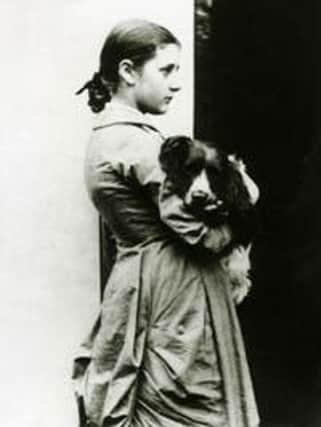150th anniversary of Beatrix Potter


In the run-up to tomorrow’s celebrations much has been recounted about the author’s extraordinarily eclectic genius.
As well as enthralling countless of millions of readers of all ages with her endearing tales about mice, rabbits and squirrels - with a recently discovered story about a cat called Kitty-in-Boots being published in September - Potter was a celebrated artist, botanist, environmentalist and archaeologist, an impeccable business woman, a tireless charity worker and a farmer and prize-animal breeder with 15 farms in her large agricultural portfolio.
Advertisement
Hide AdAdvertisement
Hide AdShe was a visionary and trailblazer who overcame professional rejection, academic humiliation and personal heartbreak, going on to amass a fortune and win a very formidable literary reputation.
There were some details here on Friday about her influence on C.S. Lewis who regarded The Tale of Squirrel Nutkin as his “second glimpse” of joy in his classic work Surprised by Joy.
Lewis said that he “loved all the Beatrix Potter books” which he described collectively as “the delight of my childhood.”
Helen Beatrix Potter, known as Beatrix, was born on 28 July 1866 to Rupert and Helen Potter in Kensington, London.
Advertisement
Hide AdAdvertisement
Hide AdThey lived very comfortably at 2 Bolton Gardens in West Brompton.
Both parents were artistically talented, and lawyer Rupert was an excellent amateur photographer.
He’d invested in the stock market, and married to an heiress, they were extremely wealthy family.
Beatrix and her younger brother Walter Bertram loved drawing and painting, inspired by their parents and by their many household pets which included rabbits, frogs, mice, various lizards and snakes, a hedgehog and several bats!
Advertisement
Hide AdAdvertisement
Hide AdBrought up and educated by governesses and tutors, the two little Potters didn’t attend school, though Beatrix was an extremely intelligent and industrious student.
Two of her early ‘artist models’ were pet rabbits Benjamin Bouncer, which liked hot, buttered toast, and Peter Piper, an expert performer of tricks.
The family often spent long, summer holidays in Scotland where the children (and some of their pets!) freely explored the countryside.
Beatrix collected and studied wild flowers and insects, which she often painted and sketched.
Advertisement
Hide AdAdvertisement
Hide AdWhen she was 16 years old the family holidayed at Wray Castle beside Lake Windermere. Here began Beatrix’s lifelong love of the countryside and particularly of the Lake District.
Back in London she was invited to study fungi at the Royal Botanical Gardens in Kew, where she produced hundreds of detailed botanical drawings and recorded details of the plants’ cultivation and growth.
By 1896 she had developed a theory about the germination of spores, an analysis of fungi that is still accepted by botanists today.
As well as illustrating plants, insects and mushrooms she loved to draw pictures inspired by her favourite childhood stories - Alice’s Adventures in Wonderland and Cinderella.
Advertisement
Hide AdAdvertisement
Hide AdSome of her drawings were accepted by a greeting-card publisher, which nurtured a desire to publish her own illustrated stories.
One of her earliest stories about Peter Rabbit began as an illustrated letter sent to governess Annie Moore’s son Noel.
Beatrix printed 250 copies of the Tale of Peter Rabbit for her family, friends and relatives before the publisher
Frederick Warne and Co. printed a first run in October 1902. It was an immediate bestseller, followed by The Tale of Squirrel Nutkin.
Advertisement
Hide AdAdvertisement
Hide AdBeatrix also found romance - her editor at the publishing house, Norman Warne.
The relationship bloomed, though Norman’s proposal was opposed by Beatrix’ parents.
Despite this, Beatrix became engaged to Norman in 1905, but was devastated when he died of leukaemia just a month later.
Even through personal tragedy, Potter’s literary successes widened and burgeoned.
Advertisement
Hide AdAdvertisement
Hide AdBeatrix had designed created and patented her first Peter Rabbit doll in 1903, and went on to explore other merchandising outlets including tea sets and bedroom slippers, a Peter Rabbit board game for two players and various other toys and games.
She loved the Lake District, which became her solace after Norman passed away, and the income from her books enabled her to invest in farmland. Her Hill Top Farm became the setting for many of her animal stories.
Local solicitor William Heelis, who assisted with her property deals, proposed to Beatrix in 1912, and they were married in London the following year. She lived in Castle Cottage in the Lake District until her death in 1943.
She was a staunch supporter of the National Trust and followed the organisation’s principles, preserving her buildings and farms in keeping with the rural culture of the area and saving the countryside from developers.
Advertisement
Hide AdAdvertisement
Hide AdShe owned 15 farms and worked on them dressed in clogs, a shawl and an old tweed skirt, helping with hay-making and wading through thick mud to unblock drains.
She bred prize-winning Herdwick sheep and was the first elected female President of the Herdwick Sheep Breeders’ Association.
Helen Beatrix Potter died on 22 December 1943 aged 77, bequeathing her farms and over 4,000 acres of land to the National Trust - and her wonderful books to the whole world!